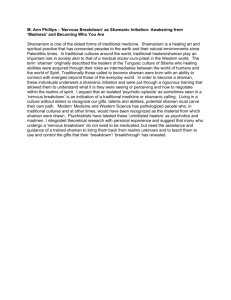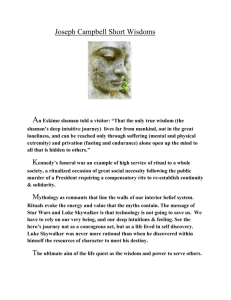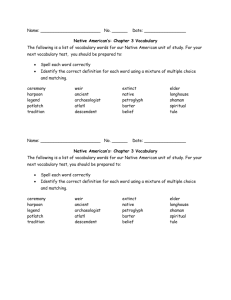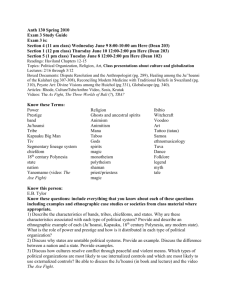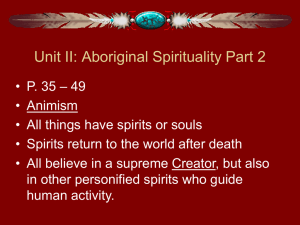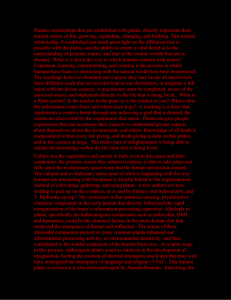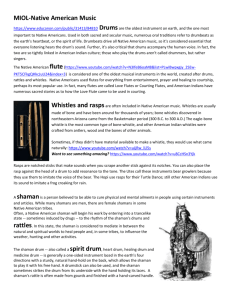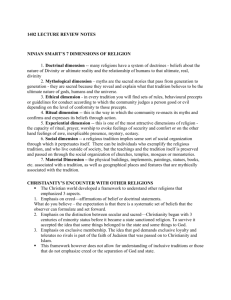The rising ground
advertisement
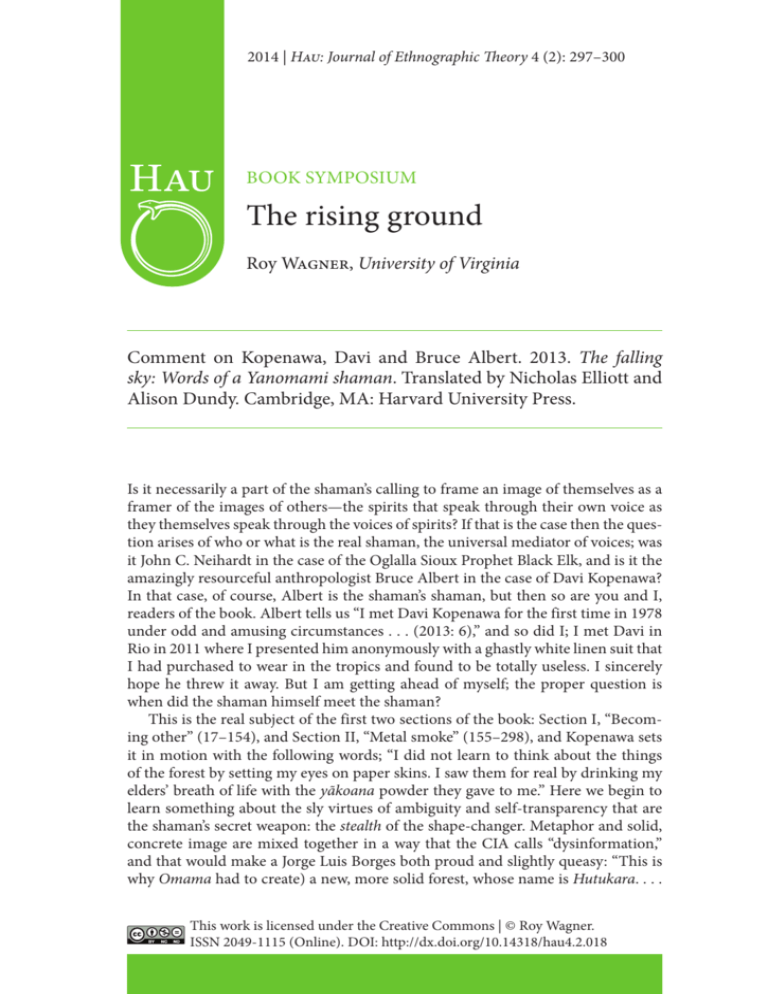
2014 | Hau: Journal of Ethnographic Theory 4 (2): 297–300 Book Symposium The rising ground Roy Wagner, University of Virginia Comment on Kopenawa, Davi and Bruce Albert. 2013. The falling sky: Words of a Yanomami shaman. Translated by Nicholas Elliott and Alison Dundy. Cambridge, MA: Harvard University Press. Is it necessarily a part of the shaman’s calling to frame an image of themselves as a framer of the images of others—the spirits that speak through their own voice as they themselves speak through the voices of spirits? If that is the case then the question arises of who or what is the real shaman, the universal mediator of voices; was it John C. Neihardt in the case of the Oglalla Sioux Prophet Black Elk, and is it the amazingly resourceful anthropologist Bruce Albert in the case of Davi Kopenawa? In that case, of course, Albert is the shaman’s shaman, but then so are you and I, readers of the book. Albert tells us “I met Davi Kopenawa for the first time in 1978 under odd and amusing circumstances . . . (2013: 6),” and so did I; I met Davi in Rio in 2011 where I presented him anonymously with a ghastly white linen suit that I had purchased to wear in the tropics and found to be totally useless. I sincerely hope he threw it away. But I am getting ahead of myself; the proper question is when did the shaman himself meet the shaman? This is the real subject of the first two sections of the book: Section I, “Becoming other” (17–154), and Section II, “Metal smoke” (155–298), and Kopenawa sets it in motion with the following words; “I did not learn to think about the things of the forest by setting my eyes on paper skins. I saw them for real by drinking my elders’ breath of life with the yãkoana powder they gave to me.” Here we begin to learn something about the sly virtues of ambiguity and self-transparency that are the shaman’s secret weapon: the stealth of the shape-changer. Metaphor and solid, concrete image are mixed together in a way that the CIA calls “dysinformation,” and that would make a Jorge Luis Borges both proud and slightly queasy: “This is why Omama had to create) a new, more solid forest, whose name is Hutukara. . . . his work is licensed under the Creative Commons | © Roy Wagner. T ISSN 2049-1115 (Online). DOI: http://dx.doi.org/10.14318/hau4.2.018 Roy Wagner 298 Omama set the image of this new land and carefully extended it little by little, like when one spreads clay to make a plate to bake a mahe cassava bread” (28). (Davi always talks that way; in Rio he asked me if I have “close knowledge of the moon.” Somewhat taken aback, I mumbled that I do indeed own a telescope. “No, no, that’s not what I mean;” he rejoined, “I mean have you ever been there? I found it difficult to even get close to the object because the winds up there are so terribly strong.”) Let that be a first lesson in the art of shamanism: it is not what you do that counts, but how you talk about it afterwards, a fey sort of storytelling that I once called “lethal speech.” Not unknown in Hollywood, it is the keynote feature in films like Saving Private Ryan, one of my favorites: Americans won the fight in Normandy not by military action, but by the careless cynicism of their speech habits. That is also how the shaman met the shaman: obviation. “As children, we gradually start to think straight. We realize that the xapiri really exist and that the elders’ words are true. Little by little, we understand that the shamans do not behave as ghosts without a reason. Our thought fixes on the spirits’ words, and then we really want to see them” (ibid.: 45). The shaman is the translator (“the one who turns the talk”) for the spirit, as the Daribi told me in Papua New Guinea. “The animals exist, nothing more. They are food for humans. They are merely imitating their images. Yet when we say one of these images’ name, we do not speak about a single xapiri, but a multitude of similar images of this spirit. Each name is unique, but the xapiri to which it refers are countless. They are like the images in the mirrors I saw in one of your hotels” (61). The shaman’s image of an image of an image recedes and joins itself to a diffuse form of pantheism that resembles nothing so much as the Eywa religion presented in David Cameron’s Avatar: “There are many mirrors on the spirits’ trails through the forest, for they belong to the xapiri of the leaves, the lianas, the trees, and all the animal ancestors” (64). As Victor Turner spoke of a forest of symbols, so Davi speaks of a forest of mirrors. They reflect us as we reflect them, but of course the mirror’s reflection always gets the image backward: “The xapiri are not like animals or humans. They are other. They do not drink river water or eat game. They hate everything salted or grilled and only eat sweet food” (71). Even in its tastes, the world of the xapiri is the inverse of our own, a natural fact that guarantees the shaman’s credibility in speaking as he does. (In the film Saving Private Ryan, Ryan winds up saving the platoon of Rangers sent out to save him.) Who would guess that the shaman’s speech is merely sanity, turned upsidedown? “It is true that the xapiri sometimes terrify us. Yet do not think that they mistreat us for no reason. They simply seek to weaken our awareness, for if we were merely alive like ordinary people, they could not make us think right” (83). This is exactly what Victor Turner called a liminal state, and what Mircea Eliade referred to as the sparagmos (“scattering”) and called to our attention as “the shamanic death,” and indeed it is presented in the chapter entitled “Initiation.” Daribi told me that the sogoyezibidi (female shaman) “must die herself and then come back to life before she can start to heal others.” “Other spirits make us be reborn. We return to being newborns, still red with the blood of our birth!” (Kopenawa and Albert 2013: 83). And Davi’s self-account also has its liminal stage, recounted in Section II, “The metal smoke.” That was the time when the mysterious other Other people (let’s not call them “white people;” I have not seen a single one of them that was really white 2014 | Hau: Journal of Ethnographic Theory 4 (2): 297–300 299 The rising ground at all, either in appearance or deed) happened upon them. The circumstances are different in different parts of the world, but it is really all the same. “Our ancestors loved their own words. They were truly happy this way. Their mind was not set elsewhere. The white people’s words had not made their way among them. They worked with uprightness and spoke of what they did” (159). There are probably ten times as many accounts of this traumatic transformation than there are different peoples in the world, but they all have one thing in common: just as the intruders speak of their efforts in terms of empty idealities and gross generalities, so their indigenous victims speak of them in terms of minute particulars. “Our fathers and grandfathers did not have a white person’s nose. They recognized the metal tools’ sickening smell from a distance. This scent seemed dangerous to them and they were afraid of it because it made them cough and immediately made them very sick” (178). Interestingly enough, indigenous accounts of situations like this are characteristically presented in absurdly subjective terms, as if they wished to create an anti-ethnography or at least get in a few lines in a third-rate literary magazine. More interesting is the way Kopenawa himself reacted to the “word magic” of these Portuguese strangers: “I did not tell myself ‘I will learn their language!’ Instead I tried to capture their words one by one and fix them inside myself ” (213). In other words, for Kopenawa, it was the words that were important, and not the language itself, a situation I had often encountered in Papua New Guinea: “You see, we call the drink in the red can ‘coke,’ but call the one in the silver can ‘kokola.’” Generally speaking, however, a shaman’s job is much simpler than that: they are supposed to remain fixed forever in their own “native villages, more or less “national treasures” of the name outsiders gratuitously apply to their ethnicity and gradually fade into the status of “ancestors.” They are not supposed to turn into “double agents,” as the CIA would have it, and spy on themselves in the cities of the enemy. “Foreign Intrigue.” “Sleeping With The Enemy.” Yet it is this aspect of Kopenawa’s self-account that recommends the book to the international community of anthropologists, makes it worth its weight in . . . well . . . xapiri. (“Due to the dramatic reviews about Chagnon’s claims about Yanomami violence, the group developed an enduring reputation among English-speaking readers for being “primitive” and warlike” [from appendix B: 462].) What about the not-so-white people, hey? “We are the only ones who are so clever! We truly are the people of merchandise! We will be able to become more and more numerous without lacking for anything! Let us also create paper skins so we can exchange them! They made money proliferate everywhere, as well as metal pots and boxes, machetes and axes, knives and scissors, motors and radios, shotguns, clothes, and sheet metal. They also captured the light from the lightning that fell to earth. They became very satisfied with themselves. By visiting each other from one city to the next, all the white people eventually imitated each other” (Kopenawa and Albert 2013: 327). This is of course the oldest story in the book, Hobbes to Rousseau to Karl Marx to Oswald Spengler to Lewis Mumford, and is hardly worth repeating again, except that it goes on in spite of that fact. Besides that, not even the most scrupulously objective ethnographer has been able to efface that little “no Nuer but a good Nuer” moral twist that has haunted our profession since the days of Tacitus’ Germania. (Tacitus got by telling his friends that they were enemies; Chagnon by pretending his bitter enemies were friends.) “When we make first contact with the 2014 | Hau: Journal of Ethnographic Theory 4 (2): 297–300 Roy Wagner 300 inhabitants of an unknown house in order to make them our friends, we exchange all that we own with them. We call this rimimuu. If we behaved otherwise, they would think Tc; were hiding our hostility” (334). In many ways Kopenawa’s version of the ageless urban man/rainforest man contrast echoes the one reported by David Guss in his translation of the Wattuna, the creation myth of the Yekuana of Venezuela: when the Creator reached the edge of the known world, and here I paraphrase, he built a city “all out of wiriki (reflecting surfaces)” so that when his pursuer, the evil Odosha, arrived there he would see his own image mirrored in everything and actually believe he was in heaven (see Civrieux 1980). For Kopenawa, “people there live piled up one on top of each other and squeezed side by side, as frenzied as wasps in their nest. It all makes you dizzy and obscures your thought” (Kopenawa and Albert 2013: 354). Urban reverse anthropology: “The lives of white people who hurry around all day like xiri na ants seem sad to me. They are always impatient and anxious not to get to their job late or be thrown away. They only talk about working and the money they lack. They live without joy and age rapidly, constantly busying themselves with acquiring new merchandise, their minds empty. Once their hair is white, they disappear, and the work—which never dies—survives them without end” (ibid.: 354–55). All shamans use that kind of rhetoric when they come to the Big City; I have heard it from my friend Wallace Black Elk in the United States of America. But none quite so eloquently as Davi Kopenawa. You get the picture/the picture gets you. And all anthropologists, perforce, get a sort of covert thrill from this, as though they were finally getting their own back. Just for the record, I once photographed Davi standing on a street in Rio, staring fixedly at a skyscraper. References Kopenawa, Davi, and Bruce Albert. 2013. The falling sky: Words of a Yanomami shaman. Translated by Nicholas Elliott and Alison Dundy. Cambridge, MA: Harvard University Press. Civrieux, Marc de. 1980. Wattuna: An Orinoco creation cycle. Edited and translated by David Guss. Austin: University of Texas Press. Roy Wagner Department of Anthropology University of Virginia Brooks Hall, 302 P.O. Box 400120 Charlottesville, NC 229904-4120, USA rw@virginia.edu 2014 | Hau: Journal of Ethnographic Theory 4 (2): 297–300
